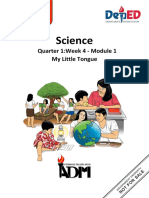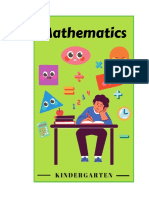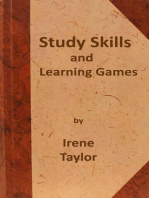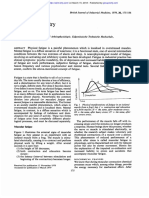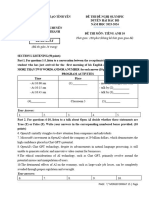Kinder 2 Science Module 2
Uploaded by
Meann Joy Barrios MendozaKinder 2 Science Module 2
Uploaded by
Meann Joy Barrios MendozaT.
Meann believes in _________________________
Please write your complete name here.
Grade & Section: ____________________________
KINDERGARTEN
SCIENCE K2
ENHANCED LEARNING MODULE
FIRST QUARTER | MODULE 2
“The Senses and Sense Organs”
Teacher Meann Joy B. Mendoza
Subject Teacher
KINDERGARTEN ENHANCED LEARNING MODULE |SCIENCE
INTRODUCTORY MESSAGE
Now, more than ever, the academic community faces new challenges brought about by the health crisis.
With this recognition, the Department of Education (DepEd), through its Basic Education Learning Continuity
Plan (BE-LCP) identified different learning delivery modalities to ensure learning even without face-to-face
instruction in the classroom. One such modality is the Modular Distance Learning (MDL), where self-learning
modules or SLMs are to be used as primary learning resources.
Valuing this need and to fortify opportunities, Pres. Quirino Treasured Child School, Inc. gives life to
Enhanced Learning Module (ELM). This is our response to the call for quality instructional resources in varying
learning delivery modalities. It features to the non-negotiable attributes of self-learning modules, namely
interactive, self-implementing, self-instructional, and compact. Our ELMs are also complaint to the learning
timeframe recommended in the DepEd Order No. 1, s. 2021.
Moreover, the ELMs are developed based on the K to 12 curriculum guides (2016). They are also
enhanced with resources in digital forms and additional contents that further engage, support, and challenge the
learners. The learning examples and opportunities within the ELMs address the six facets of the Filipino whole
learner: healthy, safe, engaged, supported, challenged and value-oriented.
After completing the discussions, activities, and exercises in the ELMs, it is hoped that the learners
become more creative and critical thinkers, life and career-ready, healthy and holistically developed. An integral
part of our aspiration is that they become lifelong learners while the PQTCS stays true to its mission in creating
quality learning solutions.
The elements of the ELMs are consistent with those stated in the DepEd Self-Learning Modules
Framework. These are as follows:
1. Introduction – Each ELMs starts with an overview of the topic or content to be covered in the module.
2. Pre-Test – This provides test items that check the learner’s prior knowledge of the lessons.
3. Target – This presents the learning objectives that are based on the K-12 learning competencies and standards.
4. Optimize – This allows the learners to review and revisit previously learned concepts.
5. Capture – This provides the learner with activities that jumpstart the discussion.
6. Navigate – This provides clear and concise discussion of the content to sufficiently develop the intended learning
competencies.
7. Enrich – Learner’s understanding of the concepts and skills are reinforced through guided and independent activities/
assessments.
8. Focus – This allows the learner to summarize and synthesize key ideas presented in the lessons.
9. Apply – This engages the learner in tasks that will enable him\her to transfer the knowledge and skills learned to real
life situations, issues and problems.
10. Post-Test – This end-of-module assessment evaluates the learner’s level of mastery in achieving the learning targets.
For the learner, the following are some reminders in using this ELM:
1. Use the module with care.
2. Read the instruction carefully before doing each task.
3. Observe honesty and integrity in doing the tasks.
4. Finish the task at hand before proceeding to the next.
If you encounter any difficulty in answering the tasks in this ELM, do not hesitate to consult your
teacher. Always bear in mind that you are not alone.
We hope that through this ELM, you will experience meaningful learning and gain deep understanding of
the relevant competencies. You can do it!
KINDERGARTEN ENHANCED LEARNING MODULE |SCIENCE
INTRODUCTION
Look at yourself in the mirror. Do you see your eyes, nose, ears, tongue, and
skin? What do you call these body parts?
In this module, you will learn about the sense organs. As you proceed with each
lesson, you will understand and be able to appreciate them as they can help you
observe and name things around you.
How are you feeling at the moment? Before working on this module together
with your parent/guardian, make sure you are rested and have eaten your meal.
Choose a learning area in your home that is well-lighted and well-ventilated. Prepare
your pen, crayon, and notebook. An Internet connection will also help you maximize
your learning.
Have fun working on this module! Cheers to your learning journey!
KINDERGARTEN ENHANCED LEARNING MODULE |SCIENCE
PRE-TEST
How much do you know about the sense organs? Look at the picture on the
left. Read the words describing an action. Tell the sense organ needed to carry
out the action. Circle this sense organ in the pictures on the right.
After taking this pre-test, let it be checked by your parent/guardian. What
is your score? Be guided with the following:
Score Meaning What to do next?
It will be helpful if you browse the
EXCELLENT! You have exemplary
5 module or answer the activities for
skills on this topic.
additional learning.
You can further improve your
knowledge and mastery by doing your
WELL DONE! You are quite skilled
4-3 best to learn more about the lessons
on this topic.
through accomplishing the activities
and answering the exercises.
Read the discussions and answer the
SATISFACTORY! You have some activities to further enhance your
2-1
knowledge about the topic. knowledge and gain mastery of the
topic.
Read the discussions thoroughly and
answer all the activities and
NEEDS IMPROVEMENT. You need
exercises. With more time and
0 to exert more effort and allot more
focus, you will surely achieve the
time to study this module.
targets and gain knowledge about
the topic.
KINDERGARTEN ENHANCED LEARNING MODULE |SCIENCE
TARGET
At the end of the module, I can:
name the five senses and their corresponding body parts.
OPTIMIZE
Look at the boy. Can you tell what he is doing in every picture?
What parts of the body did he used to:
touch the cat?
see the bug?
taste the ice cream?
smell the flower? and
hear the song?
CAPTURE
Now, with the assistance of your parents/guardians, look around. Search
around your house.
Hunt for 3 things that you can see and touch. Draw them in your Science
Notebook.
What did you used in order to see and touch them?
KINDERGARTEN ENHANCED LEARNING MODULE |SCIENCE
This time, explore in your refrigerator or kitchen, what 3 things can you
smell and taste? Draw them in your Science Notebook.
What did you used in order to smell and see them?
Move to your living room. What things can you hear? Draw them in your
Science Notebook.
What did you used in order to hear them?
NAVIGATE
Your eyes, nose, ears, tongue, and skin are your SENSE ORGANS. They
can help you observe and name the things around you.
Here are the five senses of our body and its corresponding sense organs and
functions.
Let us learn them, one by one! Come and join me!
KINDERGARTEN ENHANCED LEARNING MODULE |SCIENCE
EYES
Your eyes are the sense organs for seeing / sight. You use your eyes to see
different things.
Now, your parent/guardian will sing the song to the tune of “My Toes, My Knees.”
Listen, then sing it with your parent/guardian.
My eyes, my eyes, my eyes can see things,
The shape, the size, and the color of things,
My eyes, my eyes, my eyes can see things.
I am thankful for my beautiful eyes.
Your eyes see different colors. Your eyes see different sizes.
Your eyes see different shapes.
HOW TO TAKE CARE YOUR EYES
Here are some ways you can take care of your eyes.
Eat fruits like mangoes and bananas. Eat vegetables like squash.
Read in the place with enough light.
Sit far from the television when watching shows.
Use a clean handkerchief for wiping your eyes.
Have a regular eye checkup.
Avoid looking directly at the sun
Rest your eyes once in a while
Avoid playing with and putting sharp things near your eyes.
KINDERGARTEN ENHANCED LEARNING MODULE |SCIENCE
NOSE
Your nose is the sense organ for smelling. You can use your nose to tell different
smells or odors. Odors can be pleasant or unpleasant.
Now, your parent/guardian will sing the song to the tune of “My Toes, My Knees.”
Listen, then sing it with your parent/guardian.
My nose, my nose,
My nose can smell things
Good smell, bad smell,
Every day I smell things.
I inhale and exhale
Air with my nose
I am thankful with my very useful nose.
Your nose smells things with pleasant and unpleasant odors.
HOW TO TAKE CARE YOUR NOSE
Here are some ways you can take care of your nose.
Blow and rub your nose gently.
Clean your nose gently with a soft and clean cloth.
Avoid inserting sharp things into your nose.
Smell only the things with a pleasant odor.
Cover your nose when your smell things with bad odor.
KINDERGARTEN ENHANCED LEARNING MODULE |SCIENCE
EARS
Your ears are the sense organ for hearing. You can use your ears to hear
different sounds and sounds can be soft or loud.
Now, your parent/guardian will sing the song to the tune of “I Have Two Hands.”
Listen, then sing it with your parent/guardian.
I have two ears that I can hear,
All sounds that are far and near.
Loud and soft sounds, I hear them clear.
I am thankful for my useful ears.
Your ears can hear soft and loud sounds.
HOW TO TAKE CARE YOUR EARS
Here are some ways you can take care of your ears.
Wipe gently the outer part of your ears with a clean cloth.
Avoid putting sharp things into your ears.
Have a regular ear checkup.
Cover your ears when you hear loud sound.
Avoid listening to loud music.
KINDERGARTEN ENHANCED LEARNING MODULE |SCIENCE
TONGUE
Your tongue is the sense organ for tasting. You can use your tongue to tell the
different flavors or tastes of food. Foods can be sweet, salty, sour, bitter, and spicy.
Now, your parent/guardian will sing the song to the tune of “My Toes, My Knees.”
Listen, then sing it with your parent/guardian.
My tongue, my tongue, my tongue can taste foods.
Sweet, sour, bitter, salty, and spicy.
My tongue, my tongue can taste different foods.
I am thankful for my tongue.
Foods can be sweet, salty, sour, bitter, and spicy.
HOW TO TAKE CARE YOUR TONGUE
Here are some ways you can take care of your tongue.
Brush your tongue also when you brush your teeth.
Avoid licking or poking your tongue with sharp things.
Avoid eating very hot or very cold food quickly.
Avoid eating too much spicy food.
KINDERGARTEN ENHANCED LEARNING MODULE |SCIENCE
SKIN
Your skin is the sense organ for touching. Your skin also helps you feel things.
Now, your parent/guardian will sing the song to the tune of “Twinkle, Twinkle,
Little Star.” Listen, then sing it with your parent/guardian.
My skin helps me feel when I touch all the things, I see around me.
Some are hot, some are col. Some are smooth, some are rough.
Some are soft and some are hard. I am thankful for my skin.
Your skin feels hot things. These things are hot.
Your skin feels cold things. These things are cold.
Your skin feels smooth things. These things are smooth.
Your skin feels rough things. These things are rough.
KINDERGARTEN ENHANCED LEARNING MODULE |SCIENCE
Your skin feels soft things. These things are soft.
Your skin feels hard things. These things are hard.
HOW TO TAKE CARE YOUR SKIN
Your skin makes you feel different things. It is important to keep our skin
healthy. Here are some of the ways you can take care of your skin.
Take a bath every day.
Wash your hands with soap and water regularly.
Avoid touching very hot or very cold things.
Avoid poking your skin with sharp or pointed things
Eat nutritious food and drink plenty of water every day.
Rub your skin gently when it is itchy.
Let a doctor check your wounds or any skin problems.
Avoid staying too long under the skin.
ENRICH
Guided Activity 1. Written Work.
Label the senses on the right. Then, draw a line to match each picture to a sense.
KINDERGARTEN ENHANCED LEARNING MODULE |SCIENCE
FOCUS
Guided Activity 2. Written Work.
Complete the chart below by filling-in the correct words. Use the word bank for your answers.
skin hearing nose tasting eyes
The Human
Body
Sense
Senses
Organs
seeing
ears
smelling
tongue
touching
KINDERGARTEN ENHANCED LEARNING MODULE |SCIENCE
APPLY
Guided Activity 3. Performance Task.
You are a vlogger. A vlogger is a person who regularly posts short videos to a vlog.
Your City Health Office is will celebrate the Health Week with the theme “Keeping
a Healthy Body in the Community.” You will participate in the contest to raise
awareness in your community with the theme and the awareness drive. The video
you will create should be:
for Kindergarten pupils;
have videos about taking care of all your sense organs.
The videos will be sent on the Messenger of the Committee Chair provided with
your best caption and video title.
Let the rubric below help you assess your work as you move along.
Criteria Beginner (1-2) Capable (3-4) Expert (5)
The presentation
The presentation is The presentation is
needs to be
organized. Most well-organized. All
Presentation organized.
explanations are explanations are
Explanations are
clear. clear.
unclear.
The content was
The content was The content is
completed but the
Content completed and has completed, stable,
quality needs
few flaws. balanced and clean.
improvement.
POST-TEST
Post-Assessment 1. Written Work.
Now that you are at the end of the module, take this end-of-module assessment
to evaluate your understanding of the lesson goals.
Look at each picture. Then read the sentence. Fill in the blank in the sentence
with the correct sense.
1. I use my sense of _____________ to see the banana’s color.
2. I use my sense of _____________ to hear the phone ringing.
3. I use my sense of _____________ to feel the pillow’s softness.
4. I use my sense of _____________ to enjoy the juice’s sweetness.
5. I use my sense of _____________ to smell the perfume.
-END OF THE MODULE-
KINDERGARTEN ENHANCED LEARNING MODULE |SCIENCE
You might also like
- Behavior Solutions For The Inclusive Classroom100% (2)Behavior Solutions For The Inclusive Classroom30 pages
- Singap J Trop Geogr - Spatial Experiences of The Visually Impaired in SingaporeNo ratings yetSingap J Trop Geogr - Spatial Experiences of The Visually Impaired in Singapore17 pages
- First Step in Reading For Kinder and Grade 1No ratings yetFirst Step in Reading For Kinder and Grade 120 pages
- HG - Kindergarten Q4 Module 11 - My Community, My Responsibility100% (1)HG - Kindergarten Q4 Module 11 - My Community, My Responsibility15 pages
- Kindergarten: Quarter 1: Week 1 - I Am UniqueNo ratings yetKindergarten: Quarter 1: Week 1 - I Am Unique11 pages
- 2nd Quarter Module and Exam in SCIENCE K2No ratings yet2nd Quarter Module and Exam in SCIENCE K247 pages
- Grade 1 - Music, Arts, Physical Education and Health (Mapeh)100% (1)Grade 1 - Music, Arts, Physical Education and Health (Mapeh)26 pages
- Science: Quarter 1:week 4 - Module 1 My Little TongueNo ratings yetScience: Quarter 1:week 4 - Module 1 My Little Tongue23 pages
- SLeM Science Special Science Gr1 Q1 W2 PDF100% (1)SLeM Science Special Science Gr1 Q1 W2 PDF16 pages
- Science 3 DLP 6 - Parts of The Tongue and Their FunctionsNo ratings yetScience 3 DLP 6 - Parts of The Tongue and Their Functions10 pages
- Science 2 Quarter1 Week 2 Worksheets: Body Parts Work TogetherNo ratings yetScience 2 Quarter1 Week 2 Worksheets: Body Parts Work Together2 pages
- Science 3 DLP 1 - Sense Organs and Their FunctionsNo ratings yetScience 3 DLP 1 - Sense Organs and Their Functions16 pages
- Kindergarten Quarter 4: Unang Linggo: Pinapangalagaan Namin Ang Mga Hayop Sa Aming KapaligiranNo ratings yetKindergarten Quarter 4: Unang Linggo: Pinapangalagaan Namin Ang Mga Hayop Sa Aming Kapaligiran17 pages
- Detailed Lesson Plan in Science: Content Standard100% (1)Detailed Lesson Plan in Science: Content Standard1 page
- Kindergarten: Quarter 1: Week 4 Learning ExperiencesNo ratings yetKindergarten: Quarter 1: Week 4 Learning Experiences24 pages
- Learning Activity Sheet No.1 in Science 2: Key ConceptNo ratings yetLearning Activity Sheet No.1 in Science 2: Key Concept25 pages
- Grade 1 Science Weeks 1-4 Worksheets - Term 1100% (1)Grade 1 Science Weeks 1-4 Worksheets - Term 132 pages
- WHLP English Grade 2 - Ann Margaret v. ManguerraNo ratings yetWHLP English Grade 2 - Ann Margaret v. Manguerra4 pages
- Grade 1 English Identifying Initial A in Speech Sounds HeardNo ratings yetGrade 1 English Identifying Initial A in Speech Sounds Heard13 pages
- Ordinal Numbers/ Bilang Panunuran: Pagkilala Sa Perang Barya at Perang PapelNo ratings yetOrdinal Numbers/ Bilang Panunuran: Pagkilala Sa Perang Barya at Perang Papel8 pages
- Science3 Q2 Mod11 LivingThingsAndTheirInvironment V4No ratings yetScience3 Q2 Mod11 LivingThingsAndTheirInvironment V430 pages
- English 1 q3 Mod2 Recognizing Sentences and Non Sentences Recognizing Telling and Asking Sentences v5No ratings yetEnglish 1 q3 Mod2 Recognizing Sentences and Non Sentences Recognizing Telling and Asking Sentences v526 pages
- Final Examination Language Kinder - 2 Name: Score: I. Encircle The Nouns in The BoxNo ratings yetFinal Examination Language Kinder - 2 Name: Score: I. Encircle The Nouns in The Box4 pages
- Grade 1 Science and Health Reviewer - 1st Quarter100% (1)Grade 1 Science and Health Reviewer - 1st Quarter2 pages
- Touching The Human Significance of The Skin Compress67% (3)Touching The Human Significance of The Skin Compress514 pages
- 2324 Level N - Stories of Ourselves - Core - Students GuideNo ratings yet2324 Level N - Stories of Ourselves - Core - Students Guide51 pages
- Odor Neutralization - Assessment and Control100% (2)Odor Neutralization - Assessment and Control20 pages
- Worksheets (Grade 1) (English, Mathamatics, Social Studies and Science)100% (2)Worksheets (Grade 1) (English, Mathamatics, Social Studies and Science)51 pages
- Montessori Way of Teaching - Importance of Sensorial Exercises in MontessoriNo ratings yetMontessori Way of Teaching - Importance of Sensorial Exercises in Montessori3 pages
- What is Science_ -- Norman Robert Campbell -- New York, New York State, 1952 -- Dover Publications -- 1036925802 -- 12753a6d7e08fe06e0d08a1b060ae953 -- Anna’s ArchiveNo ratings yetWhat is Science_ -- Norman Robert Campbell -- New York, New York State, 1952 -- Dover Publications -- 1036925802 -- 12753a6d7e08fe06e0d08a1b060ae953 -- Anna’s Archive212 pages
- A Brief History of Time-Consciousness Historical Precursors To James and HusserlNo ratings yetA Brief History of Time-Consciousness Historical Precursors To James and Husserl39 pages
- The Theory of Beauty in The Classical Aesthetics of JapanNo ratings yetThe Theory of Beauty in The Classical Aesthetics of Japan175 pages
- TOA 1 - 8.0 Privacy Personal Space and TerritorialityNo ratings yetTOA 1 - 8.0 Privacy Personal Space and Territoriality48 pages
- Rudolf Steiner - Geographic Medicine GA 178No ratings yetRudolf Steiner - Geographic Medicine GA 17835 pages
- Singap J Trop Geogr - Spatial Experiences of The Visually Impaired in SingaporeSingap J Trop Geogr - Spatial Experiences of The Visually Impaired in Singapore
- HG - Kindergarten Q4 Module 11 - My Community, My ResponsibilityHG - Kindergarten Q4 Module 11 - My Community, My Responsibility
- Grade 1 - Music, Arts, Physical Education and Health (Mapeh)Grade 1 - Music, Arts, Physical Education and Health (Mapeh)
- Science: Quarter 1:week 4 - Module 1 My Little TongueScience: Quarter 1:week 4 - Module 1 My Little Tongue
- Science 3 DLP 6 - Parts of The Tongue and Their FunctionsScience 3 DLP 6 - Parts of The Tongue and Their Functions
- Science 2 Quarter1 Week 2 Worksheets: Body Parts Work TogetherScience 2 Quarter1 Week 2 Worksheets: Body Parts Work Together
- Science 3 DLP 1 - Sense Organs and Their FunctionsScience 3 DLP 1 - Sense Organs and Their Functions
- Kindergarten Quarter 4: Unang Linggo: Pinapangalagaan Namin Ang Mga Hayop Sa Aming KapaligiranKindergarten Quarter 4: Unang Linggo: Pinapangalagaan Namin Ang Mga Hayop Sa Aming Kapaligiran
- Kindergarten: Quarter 1: Week 4 Learning ExperiencesKindergarten: Quarter 1: Week 4 Learning Experiences
- Learning Activity Sheet No.1 in Science 2: Key ConceptLearning Activity Sheet No.1 in Science 2: Key Concept
- Grade 1 English Identifying Initial A in Speech Sounds HeardGrade 1 English Identifying Initial A in Speech Sounds Heard
- Ordinal Numbers/ Bilang Panunuran: Pagkilala Sa Perang Barya at Perang PapelOrdinal Numbers/ Bilang Panunuran: Pagkilala Sa Perang Barya at Perang Papel
- Science3 Q2 Mod11 LivingThingsAndTheirInvironment V4Science3 Q2 Mod11 LivingThingsAndTheirInvironment V4
- English 1 q3 Mod2 Recognizing Sentences and Non Sentences Recognizing Telling and Asking Sentences v5English 1 q3 Mod2 Recognizing Sentences and Non Sentences Recognizing Telling and Asking Sentences v5
- Final Examination Language Kinder - 2 Name: Score: I. Encircle The Nouns in The BoxFinal Examination Language Kinder - 2 Name: Score: I. Encircle The Nouns in The Box
- Study Skills and Learning Games: Teacher Tips, #3From EverandStudy Skills and Learning Games: Teacher Tips, #3
- Touching The Human Significance of The Skin CompressTouching The Human Significance of The Skin Compress
- 2324 Level N - Stories of Ourselves - Core - Students Guide2324 Level N - Stories of Ourselves - Core - Students Guide
- Worksheets (Grade 1) (English, Mathamatics, Social Studies and Science)Worksheets (Grade 1) (English, Mathamatics, Social Studies and Science)
- Montessori Way of Teaching - Importance of Sensorial Exercises in MontessoriMontessori Way of Teaching - Importance of Sensorial Exercises in Montessori
- What is Science_ -- Norman Robert Campbell -- New York, New York State, 1952 -- Dover Publications -- 1036925802 -- 12753a6d7e08fe06e0d08a1b060ae953 -- Anna’s ArchiveWhat is Science_ -- Norman Robert Campbell -- New York, New York State, 1952 -- Dover Publications -- 1036925802 -- 12753a6d7e08fe06e0d08a1b060ae953 -- Anna’s Archive
- A Brief History of Time-Consciousness Historical Precursors To James and HusserlA Brief History of Time-Consciousness Historical Precursors To James and Husserl
- The Theory of Beauty in The Classical Aesthetics of JapanThe Theory of Beauty in The Classical Aesthetics of Japan
- TOA 1 - 8.0 Privacy Personal Space and TerritorialityTOA 1 - 8.0 Privacy Personal Space and Territoriality



















